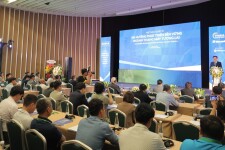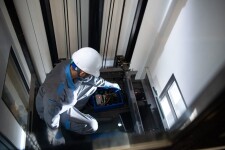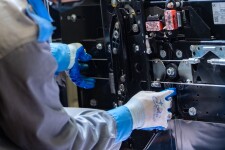1. SCOPE AND OBJECTS OF APPLICATION
1.1. Scope of application
This technical safety inspection procedure applies to the first, periodic, abnormal safety technical inspection for electric-driven elevators of classes I, II, III, IV classified according to TCVN 7628: 2007 (hereinafter referred to as elevator) under the state management authority of the Ministry of Labor, War Invalids and Social Affairs.
This procedure does not apply to reel lifts, mine lifts, stage lifts, ship lifts, exploratory or offshore platforms, construction hoists and other special types. Not applicable to some special cases such as: inflammable and explosive environment, harsh climate conditions, seismic conditions, dangerous goods transport, class V elevators are classified according to TCVN 7628:2007 , the equipment has an angle of inclination of the guide rail relative to the vertical exceeding 15°.
1.2. Subjects of application
– Organizations conducting technical inspection of occupational safety;
– Technical inspectors inspect occupational safety.
2. MANUAL DOCUMENTS
– QCVN 02:2011/BLDTBXH, National technical regulation on occupational safety for electric elevators;
– TCVN 6395:2008, Electric elevator – safety requirements for structure and installation;
– TCVN 6904:2001, Electric lifts – Test methods – Safety requirements for construction and installation;
– TCVN 7628:2007 (ISO 4190), Elevator installation;
– TCVN 5867: 2009. Elevators, Cabins, counterweights and guide rails. Safety requirements;
– TCVN 9358: 2012 Installation of equipment grounding system for industrial works – General requirements;
– TCVN 9385:2012: Lightning protection for construction works – Guidelines for system design, inspection and maintenance.
In case the national technical regulations and national standards cited in this inspection procedure are supplemented, modified or replaced, the provisions of the latest document shall apply.
The technical inspection of electric elevator safety may follow other standards at the request of the user or manufacturer, provided that such standard must have the same or higher safety specifications, against the criteria specified in the national standards referenced in this procedure.
3. TERMINOLOGY AND DEFINITIONS
This procedure uses the terms and definitions in the above referenced documents and some terms and definitions in this process are construed as follows:
3.1. Elevator:
Lifting equipment serving defined stopping floors, with a cab of suitable size and construction for the carriage of persons and goods, moving along guide rails vertically or tilted not more than 15° from the vertical.
3.2. First technical safety inspection:
It is an activity to assess the technical safety of elevators according to national technical regulations and safety technical standards after the elevator is installed and before it is put into use.
3.3. Periodic safety technical inspection:
It is an activity to evaluate the technical safety status of the elevator according to national technical regulations and safety technical standards upon the expiration of the previous inspection period.
3.4. Unusual safety technical inspection:
As an activity to assess the technical condition of elevator safety according to national technical regulations and safety technical standards when:
– After repairing, upgrading or renovating that affects the technical and safety status of the elevator;
– At the request of the establishment or the competent authority.
4. INSPECTION STEPS
During testing, the following steps must be followed:
- Check the elevator profile and history;
– External technical inspection;
– Technical test – no-load test;
– Types of load tests – Test methods;
- Processing test results.
Note: The next test steps are only conducted when the test results in the previous step are satisfactory. All test results of each step must be fully recorded in the field log according to the form specified in Appendix 01 and fully recorded at the inspection organization.
5. EQUIPMENT, TOOLS FOR INSPECTIONS
Equipment and tools for inspection must be inspected and calibrated according to regulations. Testing equipment and tools include:
– tachometer;
– Distance measuring device;
– Instruments and means of checking geometrical dimensions;
- Temperature measurement device;
– Light intensity measuring device;
– Insulation resistance measuring device;
– Ground resistance measuring device;
– Multimeter electrical measuring device;
- Ampere pliers;
- Automatic Levels Surveying (if needed)
6. TEST CONDITIONS
When conducting the test, the following conditions must be met:
6.1. The lift must be ready for inspection.
6.2. Technical records of the elevator must be complete.
6.3. Environmental factors, weather conditions do not affect the test results.
6.4. Occupational safety and health conditions must be met to operate the elevator.
7. PREPARATION OF ASSESSMENTS
7.1. Before conducting the inspection of the electric elevator, the inspection organization and the facility must coordinate and agree on the inspection plan, prepare the conditions for the inspection, and send people to participate and witness the inspection.
7.2. Check records, equipment history.
Based on the forms of inspection to check, consider the following records:
7.2.1. When testing for the first time:
7.2.1.1. Profile of the elevator:
- Must be able to show the code; year of manufacture; number of active floors; allowable working load and the main technical characteristics of the system: control device, safety device, tractor, cable, durability.
– Installation drawings of the elevator's structural assemblies, cable diagrams, objects;
– The overall drawing of the elevator with the main dimensions and parameters, the cabin dimensions;
- Working principle diagram drawing;
- Operating instructions, troubleshooting;
- Certificate of conformity issued by the designated organization according to regulations.
7.2.1.2. Installation profile:
- As-built drawings, technical acceptance records;
– The test results of grounding, insulation resistance (if any).
7.2.2. During periodic inspection:
- Curriculum vitae and results of the previous inspection;
– Records on management, use, operation and maintenance; inspection and examination minutes (if any).
7.2.3. When checking abnormality:
- Renovation and repair design documents;
- Minutes of acceptance after renovation and repair;
- Minutes of inspection by authorities.
Evaluation: Satisfactory result when complete and meets the requirements in 7.2.1, 7.2.2, 7.2.3 of this procedure. If not, the establishment must take additional corrective action.
7.3. Fully prepare suitable inspection facilities to serve the inspection process.
7.4. Develop and agree on the implementation of safety measures with the establishment before inspection. Fully equipped with tools and personal protective equipment, ensuring safety during the inspection.
8. PERFORMANCE INSPECTION
When conducting the test, the following procedures must be performed:
8.1. External technical inspection: includes the following works:
8.1.1. Check the completeness and synchronism of the elevator, assessed according to Article 3.2 TCVN 6904: 2001.
8.1.2. Check the accuracy between the manufacturer's profile and the actual installation (in terms of parameters, specifications, brands).
8.1.3. Check for defects and deformations of parts and assemblies (if any).
8.1.4. Inspect and examine the technical condition of parts and assemblies.
Evaluation: Satisfactory test results when the elevator is fully synchronous, installed according to the design, no damage, defects or abnormality detected and meets the requirements of section 8.1.
8.2. Technical test – no-load test:
8.2.1. Check machine room and equipment in engine room:
– Check the installation of equipment
– Check the entrance to the machine room, the elevations in the machine room: handrails, stairs, assessed according to sections 5.1 and 5.2 TCVN 6395: 2008;
– Check the installation position of machine clusters, electrical cabinets, measure the safe distances between them and the construction structures in the machine room, evaluate according to section 5.3.2 TCVN 6395: 2008;
– Check insulation resistance: comply with clause 11.1.5 TCVN 6395:2008;
– Checking the car wire rope – counterweight: diameter, wear, fixing the cable end… evaluated according to article 7.9.1 TCVN 6395: 2008;
– Check the cable of the overspeed governor, evaluated according to section 9.3.6 TCVN 6395-2008;
– Check the environment in the machine room: temperature, lighting, ventilation, assessment according to items 5.4.1, 5.4.2 and 5.4.3 TCVN 6395: 2008;
– Inspection of machine room doors: door panel – door lock, assessed according to section 5.3.3-TCVN 6395: 2008;
– Check electric brake: technical condition of brake wheel, brake pad, brake spring and evaluate according to items 10.3.3.1, 10.3.3.2, 10.3.3.4, 10.3.3.7 TCVN 6395: 2008;
– Check pulleys, cable orientation, protective shielding, assessed according to 7.9.6.1 and 7.9.6.2 TCVN 6395: 2008;
– Check the arrangement of electrical panels and switches in the engine room, assessed according to sections 11.4.1, 11.4.2 and 11.4.3 – TCVN 6395: 2008;
– Check the electrical wiring from the main electrical panel to the electrical cabinet, from the electrical cabinet to the machine parts and evaluate according to the items from 11.5 TCVN 6395: 2008.
8.2.2. Check the cabin and the equipment in the cabin.
– Check the gap between 2 cabin doors, the gap between the door and the cabin frame, assessed according to clause 7.5.4 TCVN 6395: 2008.
– For hinged doors: check and evaluate according to section 7.5.5 TCVN 6395: 2008.
– Check the technical condition and operation of the anti-jamming device, assessed according to section 7.5.10.2.3 TCVN 6395: 2008.
– Check the safety electrical equipment that controls the opening and closing of the cabin door according to section 7.5.11.1 TCVN 6395:2008.
– Check the condition of ventilation and lighting in the cabin assessed according to section 7.7 TCVN 6395: 2008.
– Check that the horizontal safe distance between the car door sill and the landing door threshold must not be more than 35mm.
8.2.3. Check the top of the cabin and related equipment.
– Check the space at the top of the shaft, assessed according to Article 4.6.1 TCVN 6395: 2008.
– Check the cable fixings both on the cabin side and on the counterweight side.
– Check the hatch on the car roof and the operating condition of the electrical safety contact controlling the opening and closing of the hatch assessed according to the items 7.6.1, 7.6.3 TCVN 6395: 2008.
– Check the cabin roof railing, assessed according to the items 7.3.5.3 TCVN 6395: 2008.
– Check the counterweight frame, the situation of mounting the counterweight plates in the frame, the fixing of the slabs in the frame.
– Check car guide rails and counterweights, assessed according to clause 7.10.2 TCVN 6395:2008.
– Check that the safe distance between the cabin and the counterweight, including the protruding parts of the two overhead parts, is not less than 0.05 m.
8.2.4. Check the shaft.
– Check other equipment installed in the evaluation well according to Article 4.1.3 TCVN 6395: 2008.
– Check the cover of the shaft, assess according to Article 4.2.1 TCVN 6395: 2008
– Inspect the rescue doors, inspection and assessment doors according to Article 4.2.2 TCVN 6395: 2008.
– Ventilation of the shaft: the cross-section of the ventilation hole is not less than 1% of the cross-sectional area of the shaft.
– Check the installation and operation of the upper travel limit switch.
8.2.5. Check the landing doors.
– Check the clearance between the two panels, between the panel and the door frame: this value is not more than 10 mm.
– Check the device that controls the opening and closing of the landing door: check the technical condition, the interlocking of the mechanical lock and the electrical contacts.
8.2.6. Check the pit.
– Check the environment of the pit: cleaning the bottom of the pit, water absorption, lighting.
Check the technical condition and mounting position of the main electrical panel at the bottom of the pit, including: electrical switches at the bottom of the pit, sockets.
– Check the installation and operating status of the lower travel limiters.
– Check the pit depth and vertical distance between the bottom of the pit and the lowest part of the car bottom, assessed according to section 4.6.3.5 - TCVN 6395: 2008.
– Shock absorber test: Check the position control electrical contact (for energy-absorbing shock absorbers) and check the compression stroke of the shock absorber (Appendix L-TCVN 6395:2008).
– Check the pulley, counterweight for governor
+ The condition of the counterweight support rotation joint;
+ Pulley protection
+ Rope slack control device
8.2.7. No load test
For the elevator to operate, the cabin goes up and down 3 cycles, observe the operation of the parts.
Evaluation: Satisfactory results when the device operates according to design features, no abnormal phenomena are detected.
8.3. Types of load tests – Test methods:
8.3.1. Dynamic load test in the form of 100% rated load:
Load evenly on the car floor, operate the elevator at rated speed and check the following parameters:
– Measure elevator motor current, evaluate and compare with equipment records;
– Measurement of cabin speed, assessed according to section 10.7.1-TCVN 6395: 2008;
– Test of car insurance brake (For instantaneous insurance brake or instantaneous insurance brake with shock absorber): test with test running speed, test method and evaluation according to section 4.2.3.1.2-TCVN 6904: 2001;
Evaluation: Satisfactory results when the elevator operates properly with design features and meets the requirements in Section 8.3.1
8.3.2. Dynamic load test in the form of 125% rated load:
Load 125% of rated load evenly on the floor of the cabin at the top stop, run the elevator down and check:
– Electromagnetic brake test: test method and evaluation according to section 4.2.1- TCVN 6904: 2001;
– Test of overspeed governor: test and evaluation method according to section 4.2.2-TCVN 6904: 2001;
– Test of car insurance brake: test at speed below rated speed (for quiet brake gear), test method and evaluation according to section 4.2.3.1.2- TCVN 6904: 2001
– Tensile test: test and evaluation method according to section 4.2.4-TCVN 6904:2001;
Evaluation: Satisfactory results when during the inspection process, no other defects are detected, the elevator works properly with design features and meets the provisions of Section 8.3.2.
8.3.3. Measurement of floor stopping deviation, evaluated according to section 8.7-TCVN 6395: 2008.
8.3.4. Check overload limit device: perform and evaluate according to section 11.8.6-TCVN 6395:2008.
8.3.5. Test of counterweight insurance brake (if any): test method and evaluation according to section 4.2.3.2.2-TCVN 6904:2001.
8.3.6. Test of automatic rescue kit (if any): perform and evaluate according to 4.2.6- TCVN 6904: 2001.
8.3.7. Trial of rescue alarm devices: implementation and evaluation according to section 4.2.7-TCVN 6904:2001.
8.3.8. Try elevator special programs (if available):
- Operation of the elevator when there is an incident: fire, earthquake;
- Preferred mode of running.
9. HANDLING OF INSPECTION RESULTS
9.1. Make an inspection record with full contents according to the form specified in Appendix 02 issued with this process.
9.2. Through the inspection record:
Participants in passing the mandatory inspection record must have at least the following members:
– The establishment representative or the person authorized by the establishment;
– The person appointed to participate in and witness the inspection;
- Inspectors carry out the inspection.
When the minutes are approved, the inspectors, witnesses to the inspection, the establishment's representative or the person authorized by the establishment shall both sign and stamp (if any) on the record. The inspection record is made in two (02) copies, each party is responsible for keeping 01 copy.
9.3. Briefly record the inspection results in the history of the electric elevator (specify full name of the inspector, date of inspection).
9.4. Stamping of inspection: When the inspection results of the electric elevator meet the technical safety requirements, the inspector affixes the inspection stamp to the equipment. The inspection stamp is affixed in an easy-to-observe position.
9.5. Issuance of a certificate of inspection results:
9.5.1. When the electric elevator has inspection results that meet the safety technical requirements, the inspection organization shall issue a certificate of inspection results for the electric elevator within 05 working days from the date of approval of the inspection report at basis.
9.5.2. When an electric elevator fails to meet the requirements, only the steps specified in Sections 9.1 and 9.2 shall be performed and only the inspection record shall be issued to the establishment, which must clearly state the reason for the failure of the electric elevator to meet inspection requirements, recommendations to the establishment for remedial measures and time limit for implementing such recommendations; at the same time send the inspection record and notify the local state management agency in charge of labor where the electric elevator is installed and used.
10. INSPECTION PERIOD
10.1. Period of periodic inspection is 3 years. For electric elevators that have been used for more than 10 years, the period of periodic inspection is 02 years. For electric elevators that have been used for more than 20 years, the period of periodic inspection is 1 year.
10.2. Where the manufacturer specifies or the establishment requires a shorter inspection period, follow the manufacturer's regulations or requirements of the establishment.
10.3. When shortening the inspection period, the inspector must clearly state the reason in the inspection record.
10.4. When the inspection period is specified in the National Technical Regulations, the provisions of that Regulation shall be followed.





